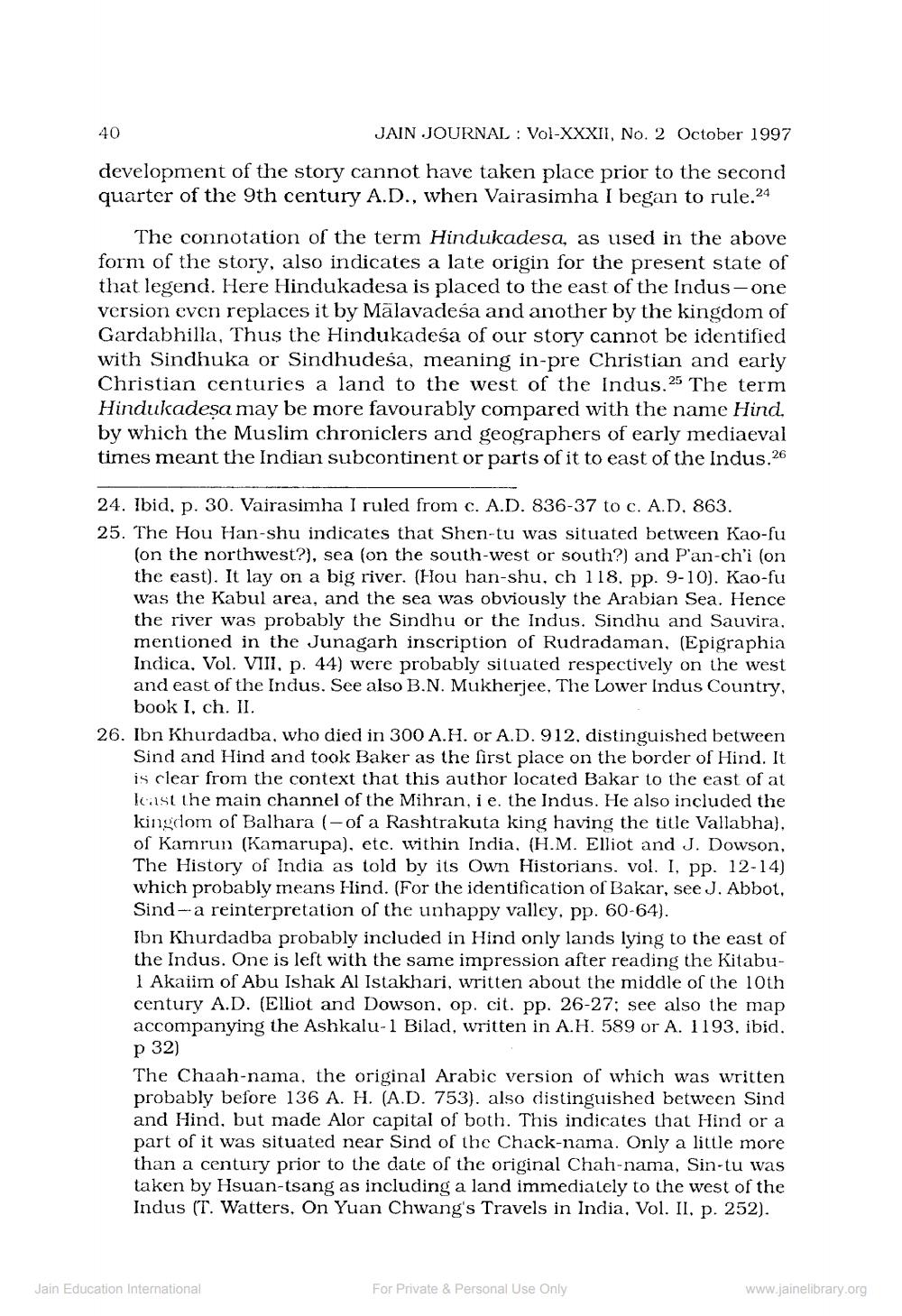Book Title: Jain Journal 1997 10 Author(s): Jain Bhawan Publication Publisher: Jain Bhawan Publication View full book textPage 9
________________ 40 JAIN JOURNAL : Vol-XXXII, No. 2 October 1997 development of the story cannot have taken place prior to the second quarter of the 9th century A.D., when Vairasimha I began to rule.24 The connotation of the term Hindukadesa, as used in the above form of the story, also indicates a late origin for the present state of that legend. Here Hindukadesa is placed to the east of the Indus-one version even replaces it by Mālavadesa and another by the kingdom of Gardabhilla, Thus the Hindukadesa of our story cannot be identified with Sindhuka or Sindhudeśa, meaning in-pre Christian and early Christian centuries a land to the west of the Indus.25 The term Hindukadesa may be more favourably compared with the name Hind, by which the Muslim chroniclers and geographers of early mediaeval times meant the Indian subcontinent or parts of it to east of the Indus 26 24. Ibid. p. 30. Vairasimha I ruled from c. A.D. 836-37 to c. A.D. 863. 25. The Hou Han-shu indicates that Shen-tu was situated between Kao-fu (on the northwest?), sea (on the south-west or south?) and Pan-ch'i (on the east). It lay on a big river. (Hou han-shu, ch 118, pp. 9-10). Kao-fu was the Kabul area, and the sea was obviously the Arabian Sea. Hence the river was probably the Sindhu or the Indus. Sindhu and Sauvira. mentioned in the Junagarh inscription of Rudradaman, (Epigraphia Indica, Vol. VIII, p. 44) were probably situated respectively on the west and east of the Indus. See also B.N. Mukherjee, The Lower Indus Country, book I, ch. II. 26. Ibn Khurdadba, who died in 300 A.H. or A.D.912, distinguished between Sind and Hind and took Baker as the first place on the border of Hind. It is clear from the context that this author located Bakar to the east of at least the main channel of the Mihran, i e. the Indus. He also included the kingdom of Balhara (-of a Rashtrakuta king having the title Vallabha), of Kamrun (Kamarupa), etc. within India, (H.M. Elliot and J. Dowson, The History of India as told by its Own Historians. vol. I, pp. 12-14) which probably means Hind. (For the identification of Bakar, see J. Abbot, Sind-a reinterpretation of the unhappy valley, pp. 60-64). Ibn Khurdadba probably included in Hind only lands lying to the east of the Indus. One is left with the same impression after reading the Kitabu1 Akaiim of Abu Ishak Al Istakhari, written about the middle of the 10th century A.D. (Elliot and Dowson, op. cit. pp. 26-27; see also the map accompanying the Ashkalu- 1 Bilad, written in A.H. 589 or A. 1193. ibid. p 32) The Chaah-nama, the original Arabic version of which was written probably before 136 A. H. (A.D. 753). also distinguished between Sind and Hind, but made Alor capital of both. This indicates that Hind or a part of it was situated near Sind of the Chack-nama. Only a little more than a century prior to the date of the original Chah-nama, Sin-tu was taken by Hsuan-tsang as including a land immediately to the west of the Indus (T. Watters, On Yuan Chwang's Travels in India, Vol. II, p. 252). Jain Education International For Private & Personal Use Only www.jainelibrary.orgPage Navigation
1 ... 7 8 9 10 11 12 13 14 15 16 17 18 19 20 21 22 23 24 25 26 27 28 29 30 31 32 33 34 35 36 37 38 39 40 41 42
